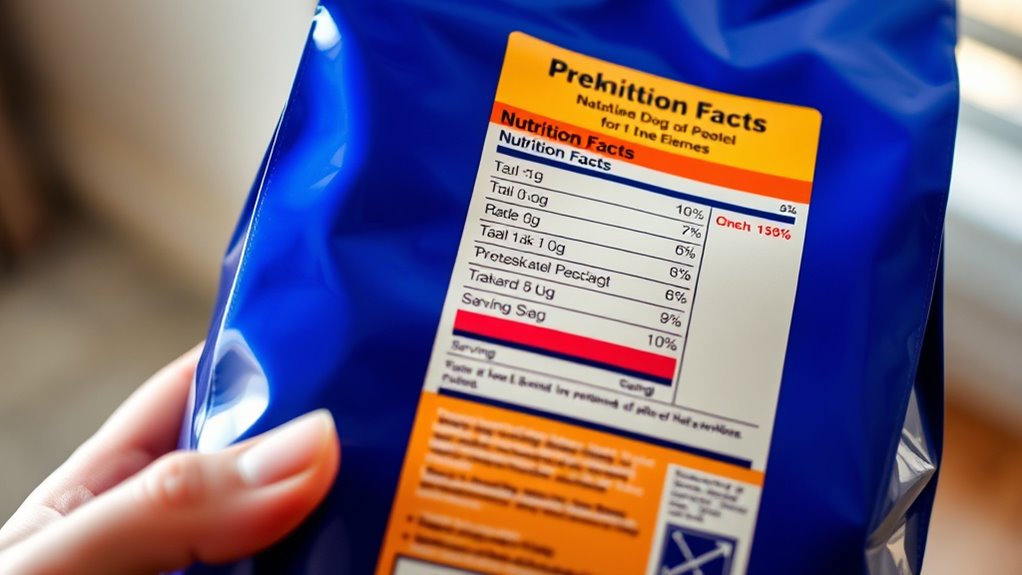To understand canine nutrition labels like a pro, start by checking ingredient sourcing to guarantee quality and transparency. Next, review feeding guidelines to give your dog the right portion size, and glance at the guaranteed analysis to gauge nutritional content. Look at the ingredient list to verify high-quality proteins and avoid fillers. mastering these steps will help you choose foods that support your dog’s health—stay with us, and you’ll discover even more expert tips.
Key Takeaways
- Review ingredient sourcing to ensure high-quality, safe, and ethically obtained ingredients.
- Follow feeding guidelines to provide appropriate portion sizes based on your dog’s weight and age.
- Check the guaranteed analysis for essential nutrients and to compare nutritional profiles across products.
- Read the ingredient list to verify the presence of real meat or fish and avoid fillers or vague terms.
- Consider additional factors like sourcing transparency and tailored nutritional needs for informed, health-conscious choices.

Have you ever looked at your dog’s food label and felt overwhelmed by all the information? You’re not alone. Canine nutrition labels can seem complicated at first glance, but understanding them is vital for making informed decisions about your dog’s diet. One of the first things to pay attention to is ingredient sourcing. This tells you where the ingredients come from and can give you insight into the quality and safety of the food. Look for labels that specify the origin of key ingredients, such as “sourced from USA” or “sustainably farmed.” Knowing where the ingredients originate helps you assess the product’s transparency and quality standards. For example, ingredients sourced from reputable farms or suppliers are often more reliable and less likely to contain contaminants. This knowledge allows you to choose foods that align with your values and your dog’s health needs.
Next, familiarize yourself with the feeding guidelines printed on the label. These are usually presented as recommended daily amounts based on your dog’s weight or age. Feeding guidelines act as a useful starting point, but remember they’re just recommendations. Your dog’s activity level, metabolism, and health conditions might require adjustments. The guidelines are designed to help you avoid overfeeding or underfeeding, which can lead to obesity or nutritional deficiencies. Use these as a baseline, but don’t hesitate to consult your veterinarian for personalized advice, especially if your dog has special dietary needs. Proper portioning based on the feeding guidelines ensures your dog gets the nutrients they need without excess calories. Additionally, understanding the guaranteed analysis helps you compare the nutritional value across different products effectively.
Understanding the label also involves reading the guaranteed analysis, which details the minimum levels of crude protein and fat, along with maximum levels of fiber and moisture. This provides a snapshot of the food’s nutritional profile. When comparing products, pay attention to these numbers to ensure your dog’s diet meets their specific energy requirements and health conditions. For example, active breeds or working dogs may need higher protein content, while senior dogs might benefit from lower fat levels.
Finally, always check the ingredient list itself. Ingredients are listed in order by weight, so the first few should be high-quality protein sources like real meat or fish. Avoid foods with vague terms like “meat by-products” or fillers like corn and soy if you’re aiming for a premium diet. By paying close attention to ingredient sourcing, feeding guidelines, and nutritional info, you equip yourself with the knowledge to select a food that truly supports your dog’s health. It’s a small effort that pays off in a happier, healthier pet.
Frequently Asked Questions
How Often Should I Update My Dog’S Diet Based on Nutrition Labels?
You should review your dog’s diet and feeding schedule every few months to guarantee optimal health. When updating their diet based on nutrition labels, aim for a gradual diet shift over 7-10 days to prevent stomach upset. Regularly check ingredient lists and nutrient content, especially if switching brands or types of food. Staying attentive helps you maintain a balanced diet, keeping your pup happy and healthy as their needs change.
Are Organic Labels on Dog Food More Nutritious?
You can’t judge a book by its cover, but organic labels often hint at quality. While organic certification means fewer pesticide residues and fewer synthetic additives, it doesn’t automatically make the food more nutritious. Look beyond the label, check the ingredients, and consult your vet. Organic options may support healthier choices, but they’re not a magic bullet. Focus on your dog’s specific needs and overall diet for the best results.
How Do I Interpret Ingredient Lists for Quality?
When interpreting ingredient lists, focus on the ingredient hierarchy—ingredients are listed from most to least prevalent. Look for high-quality proteins and whole foods at the top. Also, consider additive significance; avoid foods with unnecessary fillers, artificial preservatives, or colors. A clear, natural ingredient list indicates better quality. You want ingredients that support your dog’s health, so prioritize those that are recognizable and beneficial, ensuring a nutritious meal.
Can Nutrition Labels Help Identify Food Allergies?
Nutrition labels can help you identify food allergies by showing ingredients that might trigger grain allergies or additive sensitivities. You should look for common allergens like wheat, corn, soy, or artificial additives. Reading labels carefully allows you to spot potential problem ingredients early. If your dog has known allergies, choose foods with simple, limited ingredients and avoid anything that might cause a reaction, ensuring their safety and well-being.
What’s the Best Way to Compare Two Different Brands?
When comparing two brands, you should first check ingredient sourcing to guarantee high-quality, natural ingredients. Next, review the manufacturing standards listed on the labels to confirm safety and consistency. Look for transparent ingredient lists, minimal fillers, and reputable sourcing practices. By focusing on these factors, you’ll make informed choices, selecting the food that best supports your dog’s health and aligns with your values.
Conclusion
Now that you’ve revealed the secrets of canine nutrition labels, you’re armed with the power to make smarter choices. Think of yourself as a detective, uncovering hidden clues to keep your furry friend healthy and happy. Every label is a map guiding you to the treasure of ideal nutrition. With this knowledge, you can navigate the pet food aisle confidently, ensuring your pup’s well-being shines brighter than ever—because a well-fed dog is a happy, thriving companion.










